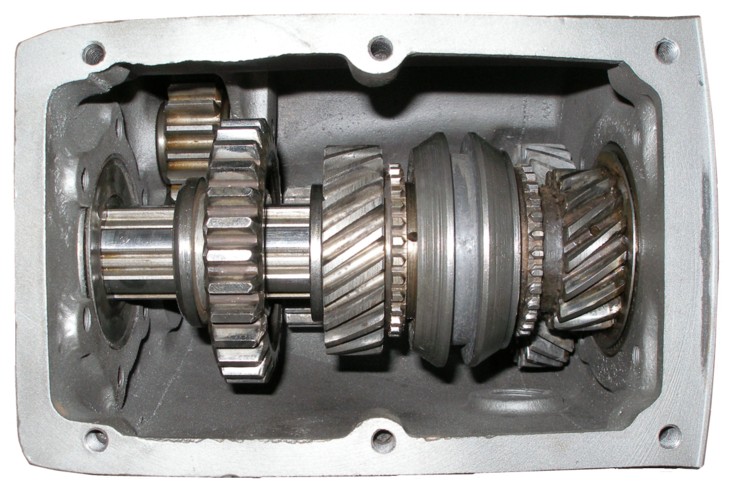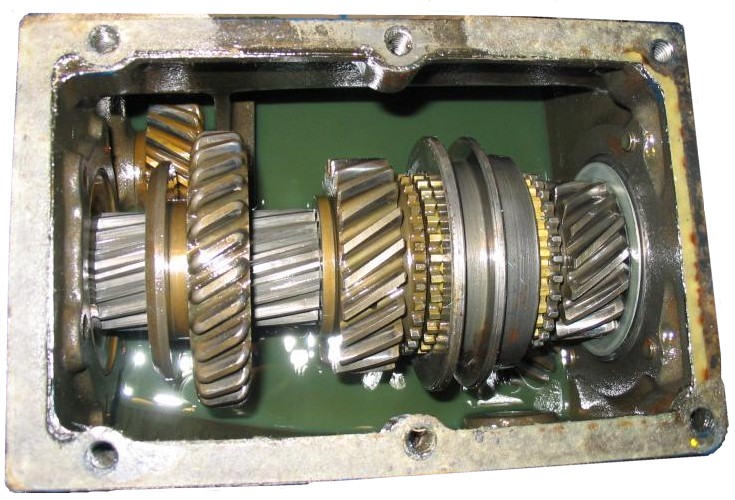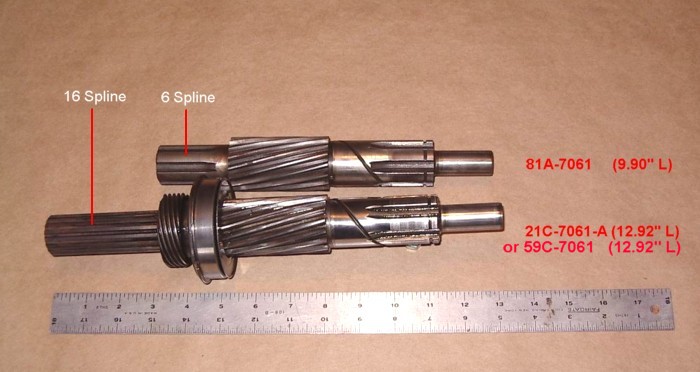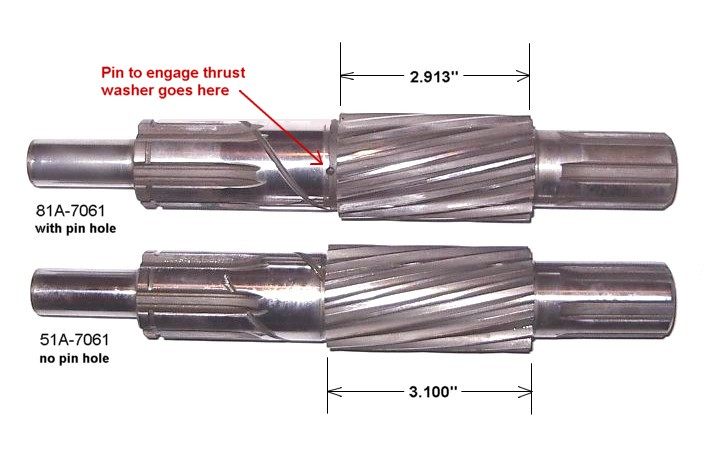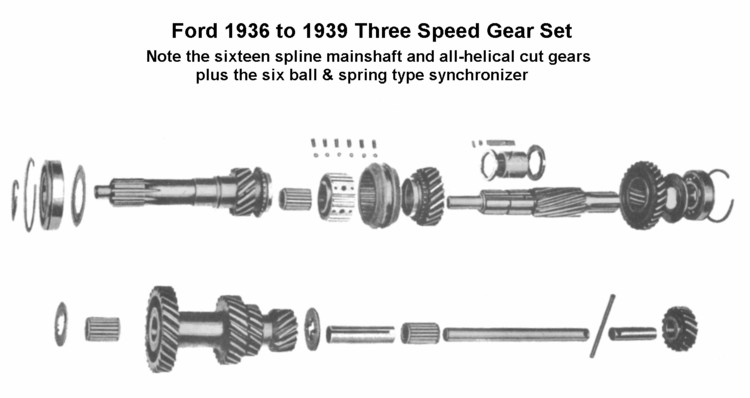|
Ford Top Loader Three Speed Transmission |
 |
|
Home Parts Drawings Web Links Tune-Up & Service Serial Numbers Engine ID Trans Identification Model ID Terms of Sale Contact Us Our Online Store Our Catalog |
|
Gear Sets There were three basic gear sets used in the Ford transmissions from 1932 to 1948 (and to 1952 in the continuation of this transmission in the Ford light duty pickup trucks). The early units up through 1935 were easily identified by the straight cut gears on the Low/Reverse slider and the Reverse Idler gear. They also had a six spline mainshaft with straight splines where the low/reverse slider gear travels. The early straight cut (or "spur") gears, which were just the low and reverse, made more of the gear whine sound than the helical cut gears. The 1932 to 35 gears (with the straight cut teeth) were fitted by Ford in two variations. Since certain parts are NOT interchangeable, it is important to keep the correct parts together. The key parts involved are the 7017 Main Drive Gear, the 7113 Cluster Gear, and the 7106 Synchronizer Sleeve. The differences are subtle but can be measured easily with a caliper or micrometer. Click on this LINK for the dimensions in the Ford Service Bulletin. In 1936 Ford introduced an upgrade to their three speed transmissions, whereby the Low/Reverse slider gear and Reverse Idler gear were now helical cut like the rest of the gears in the box. A helical cut puts the gear teeth at an angle which reduces gear whine and improves gear engagement. The mainshaft was also changed to a spiral spline, which produced the same effect as the helical cut. The synchronizer design remained the same. For 1936 only, the mainshaft came with two spiral splines: the early one was a six-spline shaft and the other was the sixteen-spline shaft that became the standard for all the Ford designed transmissions to follow for a number of years. In 1939 Ford began to introduce the next upgrade to their transmission. Installed in the Deluxe Fords and the Mercurys, the newer gears were not interchangeable with the older gears, although one could swap a complete gearset into the older transmission case, as long as you also upgraded the shifter housing assembly. The newer gears were all helical cut, of course, and the synchronizer assembly was improved. The upgrade to the synchro meant a change in the main drive gear and the mainshaft. This newer assembly was used up to 1948 in the passenger cars with the closed drive (torque tube). In 1942 Ford changed the light pickup trucks to open driveshafts, at which point they modified the three speed light duty transmission to accommodate the change. The basic difference with the open drive transmission was the use of a longer mainshaft with a different spline on the tail end, and a revised rear bearing retainer. The new retainer (which doubled of course as the rear trans mount) has the same bolt pattern to attach to the 78 series case, but incorporates the speedometer drive gear in its casting. With the correct mainshaft and rear bearing retainer, you can use these parts in the 1939 trans to create an open drive arrangement for these units. It is important that you match up the sliding 1st/reverse gear to the mainshaft's spiral spline as there are two variations to the twist of the spline. Not pictured below is the 1951-52 gearset used in the light duty 3 speed transmissions in the F series pickup trucks. These gears will fit into the 78 series gearbox, but they will not interchange with the earlier 1932-50 gears. You must keep these in complete sets if they are to be used in the 78 series toploader gearbox. Likewise, the 51-52 gears are open-drive only. You cannot mix them with any of the closed drive gears. These newer gears look similar to the pre 1951 gears but have different tooth counts, tooth angles, and the mainshaft has a different angle on the spiral splines. |
|
|
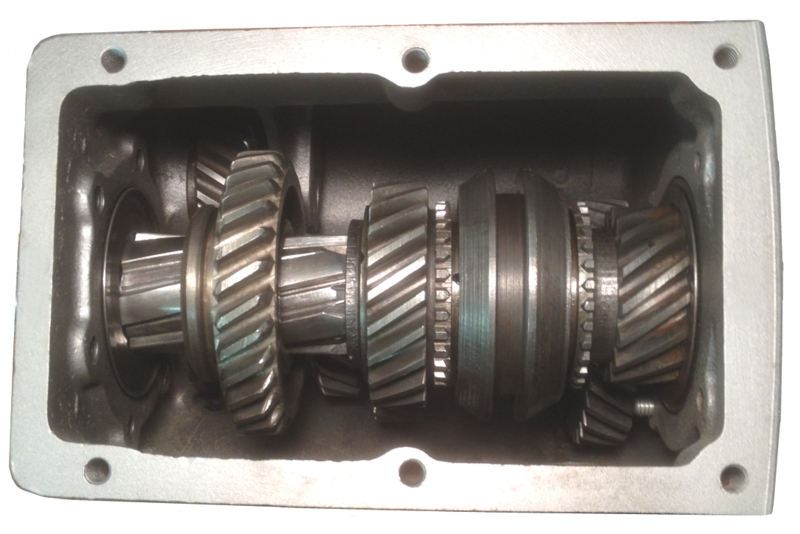 The gear set pictured above is the early 1936 style. All gears are helical cut. The mainshaft seen here is the first with the spiral splines for the low/reverse slider gear. There are just six splines in this section, and there are relief notches to allow the second gear lock key to clear. The old style synchro has the center groove, but you can see a slight lip on the front edge. The "teeth" of the synchros are actually part of the intermediate gear and the main drive gear (rather than the two separate brass rings used on the 1939 and later synchronizers. |
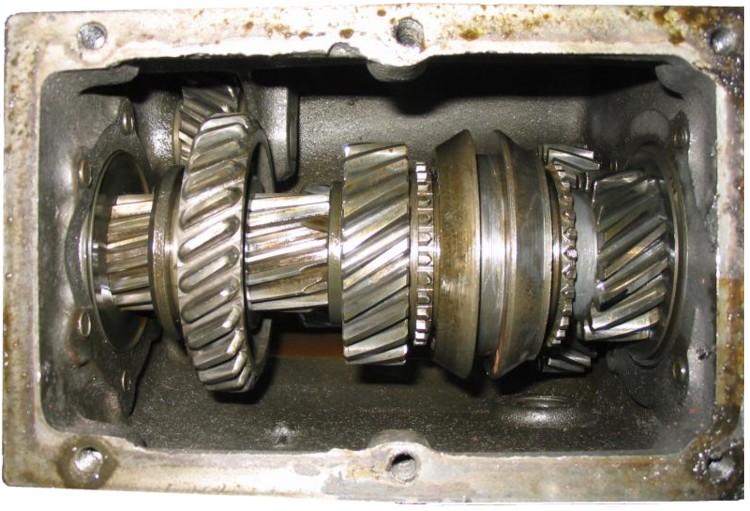
The gear set pictured above is the late 1936 to 39 style. All gears are helical cut. The mainshaft has the unusual "cut-outs" at the forward end, next to the intermediate gear and thrust washer. These are not chips or defects, but are part of the mainshaft design. The old style synchronizer has the center groove, but you can see a slight lip on the front edge. The "teeth" of the synchros are actually part of the intermediate gear and the main drive gear (rather than the two separate brass rings used on the 1939 and later synchronizers. |
|
|
|
The longer rear extension had the 16 splines which carried the front yoke and U-joint of the open driveshaft. From the bearing forward these mainshafts were very similar. The shorter mainshaft is useless as an open drive because the rear extension is too short for a driveshaft yoke to have normal front to rear movement. |
|
The above picture compares the two common mainshafts used in the 1939-48 closed drive transmissions. The 81A-7061 shaft has the small pin-hole with a steel pin to engage the internal teeth of the 81A-7071 thrust washer. This style came with the 01A type synchronizer (3 balls and springs) which also used the 81A-7069 thin brass thrust washer. When all parts were in place the snap ring fits in its groove right up next to the front of the synchronizer hub. The 51A-7061 mainshaft does not use either of the above-mentioned thrust washers. Second gear fits right up against the spiral splines, and the 51A or 8M type synchro (two wire spring retainers) fits up against second gear. The obvious difference is the lack of the pin hole, but you can also see the difference in the length of the spiral splines. Since the 51A/8M synchro hub is slightly thicker than the 01A synchro hub, you can not use it in place of the 01A on the earlier (81A-7061) mainshaft. With the correct parts in place, the front edge of the synchro hub will end up right at the snap ring groove, so that all the gears are in their proper position. |
|
|
|
Ford 1939 Transmission Webpage Copyright 2023 - VANPELT SALES LLC - All rights reserved |
